Search Posts
Recent Posts
- Cranston Councilor Germain’s resignation charges get swift response, call for investigation April 18, 2024
- We Cook! Mill’s Tavern Short Rib Sage Polenta April 18, 2024
- Rhode Island Weather for April 18, 2024 – John Donnelly April 18, 2024
- Providence: A new culture in City Hall – Mayor Smiley’s FY25 Budget April 18, 2024
- RI Veterans: Did you know? 18.04.24 (100th bday, events, Q/A, fishing, resources) – John A. Cianci April 18, 2024
Categories
Subscribe!
Thanks for subscribing! Please check your email for further instructions.
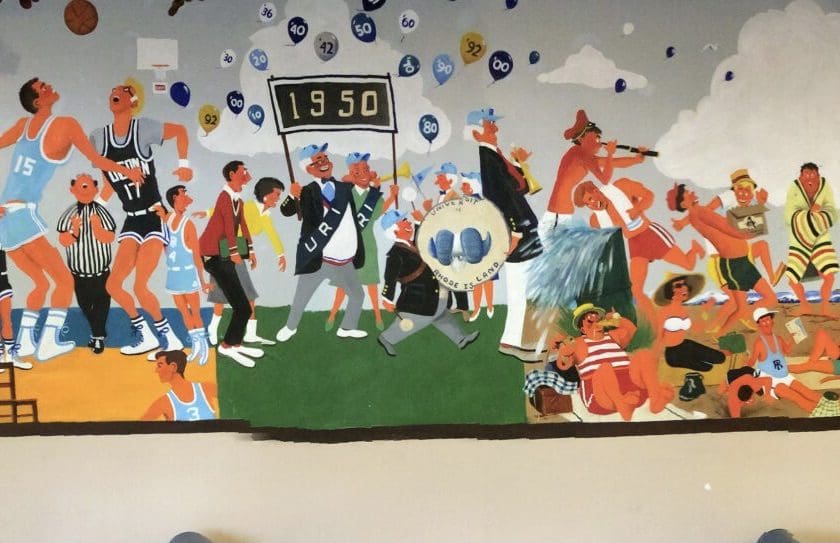
URI asking “everyone” about fate of RI’s historic veteran-themed mural
URI is asking for input and suggestions “from everyone” about the future of a set of historic murals painted by Doctor/Corporal, retired professor, and URI Hall of Famer Arthur Sherman, Class of 1950.
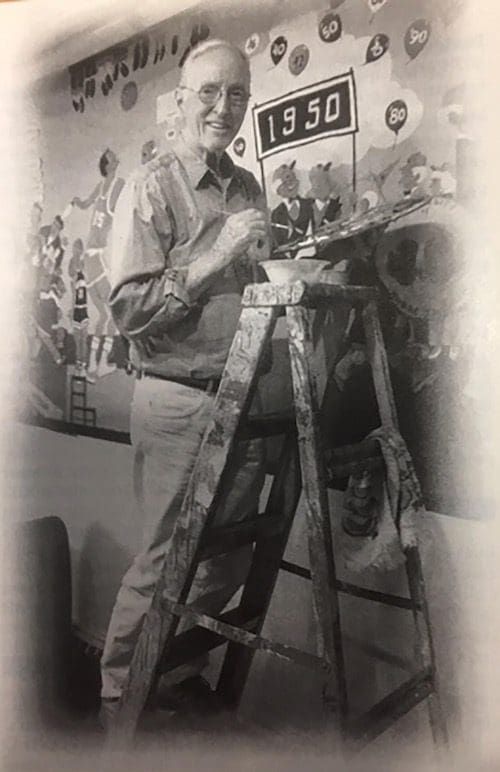
Sherman, who is now 96 years old, was commissioned to paint the mural depicting soldiers returning from war to URI, as part of the federal GI Bill to help veterans return to school. The Memorial Union was built, itself, as a War Memorial, in memory and honor to the university’s veterans. The mural came up for discussion in 2019 and 2020. The cartoon style work was a collective as students would come by and make suggestions to the artist of figures or items to be included and he would incorporate them into the design.
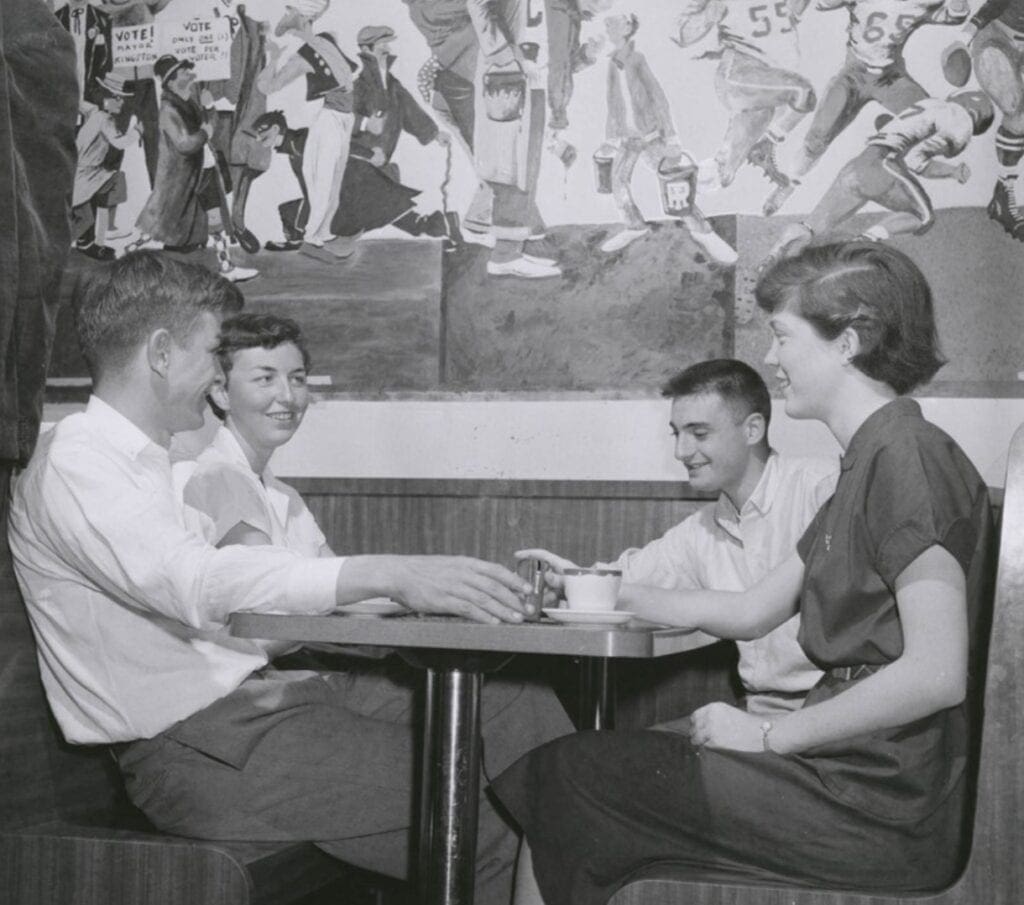
Here is the email sent out by URI’s Office of Communications:
The University of Rhode Island has established a diverse committee consisting of students, alumni, staff and faculty to consider suggestions and input regarding the future of murals in the lower level of Memorial Union painted by Dr. Arthur Sherman, URI class of 1950. Based on feedback from students and others in the URI community, the University decided to cover the murals last summer. Since that time, the University has heard from numerous alumni and other community members about what should be done with the artwork.
Last fall, the University set up the committee to receive suggestions and eventually make recommendations to the University leadership.
Everyone is encouraged to send their comments and suggestions to [email protected] by May 16.
The committee will consider carefully the comments and suggestions of the community as part of its report to University leadership at the end of May.
The committee, which meets weekly will:
• Consider opinions from current students, alumni, and community members
• Consider multi-disciplinary perspectives of committee members
• Research the history of the murals and Dr. Sherman
• Produce a report outlining recommendations for the current and future status of the murals.
The committee members are:
Kevin Lopes (co-chair), ‘05, alumni member
Rachael Garcia (co-chair), assistant director for Veterans Affairs and Military Programs
Carl Stiles, director of the Memorial Union
James Hopkins,’62, alumni member
Angie Tyson, Student Senate representative
Ronald Onorato, professor and chair of the Department of Art and Art History
Zack Nardone, student veteran representative
Anita Burke, senior word processing staff member, Gender & Sexuality Center.
_____
In 2014, URI noted, in a celebration of the 60th anniversary of the Memorial Union: “An intricate piece of the Memorial Union that still remains intact is the Class of 1950s mural spanning two walls on the first floor of the Union. Art Sherman, a member of the class of 1950 who painted the mural, depicted his fellow classmates in a variety of settings. Renovations required minor repairs, and Sherman, now in his 90s, has come back several times to make repairs.”
Reprint selections of RINewsToday September 13th article, Veteran’s mural sparks educable moments at URI. Or not…, in RINewsToday:
Racial equity issues have us looking at everything with fresh eyes. We look at the words we use, the colloquial phrases that are part of some of our languages, perhaps ingrained over generations. We look at symbols and photos. Logos and graphics. We look at statues. We look at art. And public art, in particular.
At URI there are a set of unique murals done in the 50s by a veteran returning on the GI Bill to college – he would later teach at the university, as well. Today he is 95 years old, and very aware of what might be in store for his murals; those that he has dutifully touched up over the years. The murals are in Memorial Union, itself built to honor veterans.
Thousands – hundreds of thousands – have walked by the art since 1954, where the colorful, whimsical look at university life at that time surely gave a smile or a chuckle to many. Many who might not be having the best of days. Some probably stopped for a few long minutes looking at each caricature, pondering what the artist had in mind.
Now, college officials have said the mural is insensitive to a changing demographic in higher education – to the student body at URI – it didn’t represent the diversity and racial equity the university would like to have reflected of the university body today.
URI announced it would be taking down the mural and it may be replaced with public art more acceptable 66 years since the 29-year old young veteran painted, with students and passersby suggesting to him that he add this figure and that detail as it went along, becoming somewhat designed by the collective group around it (a very 2020 thing to do).
The push back has grown. From some in the general URI community, on social media, and from veterans who see it very much in the style of Norman Rockwell’s whimsy at a time of war, and a time after war.
As we write this the mural has been covered over. URI has said it will not be part of the student union once renovations are finished.
“The media got ahead of us”
Following a front page story done by the Providence Journal, a story by NBC10, lots of social media, and now veterans, URI has sent out an email to alums, explaining itself, saying it will keep the group informed as the issue is discussed – while doubling down that whatever it done, it will not remain in the Memorial Union, itself a “war memorial”, according to URI.
It is important to remember that URI is a state school. The public art is its property. The school and the art are the property of the people of the state of Rhode Island. Removing it may not be as quick and easy as it might be for a private college or university, who could simply vote to do it. Who decides?
The artist – Corporal Arthur Sherman – URI Hall of Famer
The artist is Arthur “Art” Sherman, a 1950 graduate of URI. Sherman had been an associate professor, and was also a four time All American in track and field, a coach, and a URI Hall of Famer. Sherman was an Army corporal in World War II, serving in Alsace-Lorraine at the French-German border. The GI bill provided opportunities for soldiers returning from war to continue their education, as Sherman did.
According to an interview with NBC10, Sherman’s murals “depict servicemen returning to Kingston, a class reunion, URI commencement, a South County beach scene, and students piled into a jalopy wearing letter sweaters. The mural has been left untouched for nearly 70 years, with Sherman dutifully touching them up from time to time to keep the art in a good state.
Sherman, who is now 95 years old, was asked to paint the murals. He told NBC10: “Oh, I loved painting that, yeah…I never had any formal education in painting, by the way, I just used to cartoon.”
Sherman said it became a collective work as “A lot of students, friends of mine, would come by and say, why don’t you do this, why don’t you do that? So, that’s what I did – so everybody chipped in.
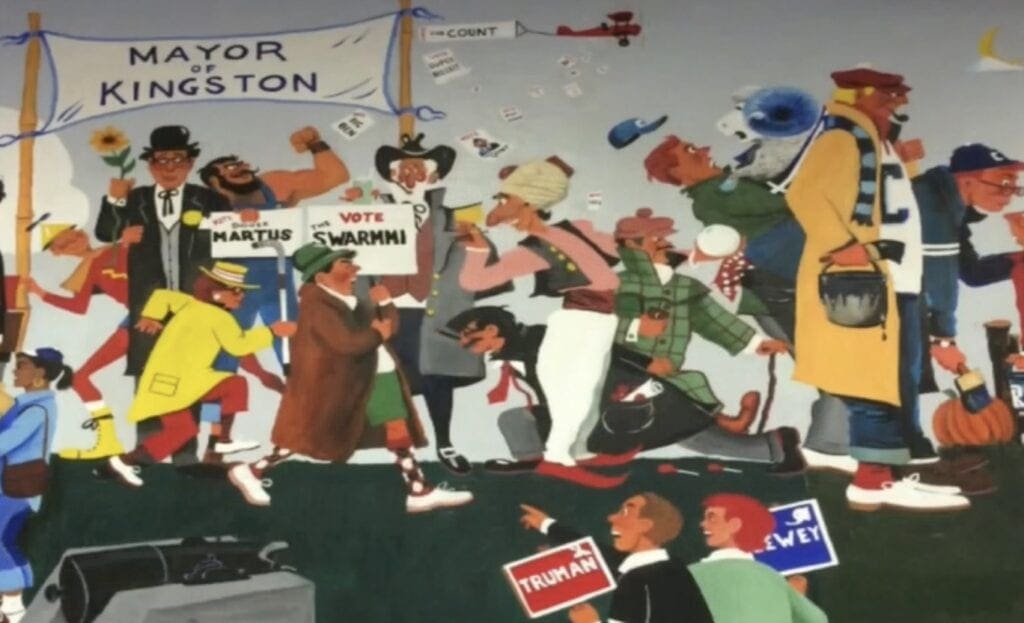
What URI is saying now
A few days ago [Sept. 2020] URI sent an email out to the community. It is reprinted here:
Dear University of Rhode Island alumni:
We understand the affinity that many of our alumni and community members have to the murals displayed in the URI Memorial Union. We appreciate the emotional connection many have to the past as depicted in the murals showing campus life in the 1950s.
The murals commemorate student life at URI in the 1950s. They are not World War II murals and in no way do they “depict the events of World War II” as some media outlets have stated. There is not one single image or section of the murals that depict the events of World War II.
Misleading and inaccurate reporting by some media outlets of this situation has caused a great deal of concern among members of our URI community, including the University officials who have worked hard to honor our veterans and have an unwavering appreciation for their service.
In no way was the decision to alter the space in the Memorial Union connected to any disregard or insensitivity toward our veterans. We are committed to our veterans. Our Office of Veterans Affairs and Military Programs and our very active Student Veteran Organization both view this artwork as a depiction of a specific period of time and not reflective of campus and military culture today.
The Memorial Union itself, the center of student life at URI, is a war memorial, but the murals are whimsical cartoons that also show a class reunion, URI commencement, a South County beach scene, students piled into a jalopy wearing letter sweaters and a marching band.
The necessary renovation of the Memorial Union brought to light the issue of the condition of the murals. During this process, we explored options for preservation of the murals, including removal of the plaster walls on which the murals are directly painted. The construction method of the wall – plaster and lathe – does not permit removal without damage to the murals and to the walls.
The University has enlisted the assistance of Professor and Chair of the Department of Art and Art History Ronald Onorato to share his expertise with regard to mural preservation, with the goal of incorporating the work of the artist, Dr. Arthur Sherman. As Professor Onorato notes: Most importantly, we should strive, as an educational institution not toward removing history but moving toward contextualizing the mural to use the original mural as a way to open discussions about our University culture in the 1950s and how it differs from who we are now.
When we complete the renovations, we will invite the Sherman family to the ceremonies to thank them for their contributions to the University. The University will announce plans on how it will proceed by the end of September.
We are a community that values equity and diversity, and we will work to ensure that our students, alumni and community members of all backgrounds feel welcome and included.
_____
American War Veterans of RI responds – Does URI Have The Legal Rights To Paint Over Mural
Submitted by: John Cianci, Italian American War Veterans of Rhode Island
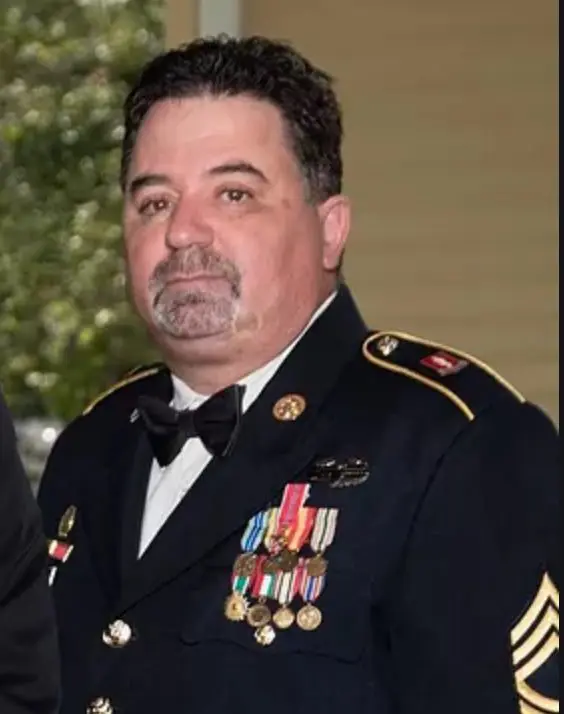
I question URI attempting another action that disrespects Veterans for the second year in a row; let’s recall, last year Student Veterans of America and ACLU had to petition faculty not to schedule classes on Veterans Day. https://rhodycigar.com/2019/02/21/student-veteran-organization-american-civil-liberties-union-create-joint-petition/
First, does URI have the legal authority to paint over the wall? One could argue any action by URI could subject the State of Rhode Island to millions of dollars of liability if URI does not comply with the Visual Artist Rights Act (VARA), passed by Congress in 1990.
VARA is the embodiment of artists’ moral rights, but like most rights, those moral rights can be waived by the artists in question. VARA deals both with works of art that can and cannot be removed. VARA’s protections do not extend to works of visual art incorporated into a building in such a way that removing the work will cause destruction, distortion, mutilation or modification of the work if the artist consented to such installation prior to VARA’s effective date or where a written instrument is signed by the owner of the building and the artist specifying that the work in question may be subject to destruction, distortion, mutilation or modification by reason of its removal.
Whereas, the artist, Mr. Sherman is living, has the artist been properly notified in accordance with VARA. This notification should have been given with the option to preserve his artwork.
Has URI looked at other options to preserve the mural?
For example, the mural could be sealed with urethane and placing vinyl wall covering, which years later could be removed and preserve the artwork. Another option, have the artist modify the painting with the words “1954 URI Students”.
Whereas, one could argue the current student body is made up of Afghan/ Iraqi War Veterans serving since 2004 (50 years after the mural was created, WWII veterans made up a portion of the student population), why not seek one or two students to do a mural on the opposite wall {of this war memorial building} with the diversity of current student bodies. I can visually see the laughter of viewers of the art when they compare the two.
Veterans throughout the State of Rhode Island are united to ensure the mural at URI is not painted over and destroyed forever.
The Italian American War Veterans of The United States, Department of Rhode Island (ITAM-RI) and many of the Veteran organizations will be reaching out to URI staff to discuss other options to preserve the mural, a piece of history which includes World War II Veterans attending URI in the 50’s.
Artwork paying tribute to our Veterans should never be destroyed. As a nation, we owe it to all who have served, to leave no stone unturned to save history honoring those willing to sacrifice their lives.
Preserving history honors our Veterans. Destroying artwork honoring our Veterans is disrespectful and all Americans, especially alumni veterans of URI should be outraged if URI destroys it.
Any action by URI to destroy this mural sends a clear message to Veterans and future Veterans how they will be treated by the University of Rhode Island, our state university.
“It’s about how we treat our veterans every single day of the year…in the United States of America.”
— Barack Obama
(Note: We offered an opportunity to the RI Veterans Director to provide a comment, but it was not received by publication time.)
__________
The GI Bill came out of protest as 20,000 returning soldiers marched on Washington
The assimilation of World War I veterans back to civilian life didn’t go well. With so many men flooding the labor market, many couldn’t make ends meet, even with help from government programs. Congress stepped in and passed the Bonus Act of 1924, which promised veterans a bonus based on number of days served. But it wouldn’t be paid until 1945, almost 20 years later, much too late to help countless struggling veterans.
By 1932, during the Great Depression, around 20,000 frustrated veterans—known as Bonus Marchers – marched on the Capitol in Washington, DC, demanding their bonus money. President Hoover sent the Army to get them out, a move which pitted soldier against veteran. The confrontation would be an integral turning point in the crusade for veteran’s rights.
President Roosevelt would sign the GI Bill into law on June 22, 1944. The Bill has changed over the years – and followed soldiers back from the Gulf War, the Vietnam War, etc. There is history of racial discrimination in African-Americans trying to be educated after fighting for their country. Versions of GI Bills have been changed, altered, but in 2017 the “Forever GI Bill” was signed into law by the president.
What say you?
Imagine the discussions that this mural controversy could inspire? Imagine if URI took an educable eye to the whole thing – and put down its broad paintbrush, so eagerly waiting to make it gone? Could it not serve as a discussion about the GI Bill, the role of veterans in our history, why the Memorial Union was built, and how higher education was part of many veterans path back to civilian life?
If you would like to express your opinions on the murals and their future, send us an email at: [email protected]
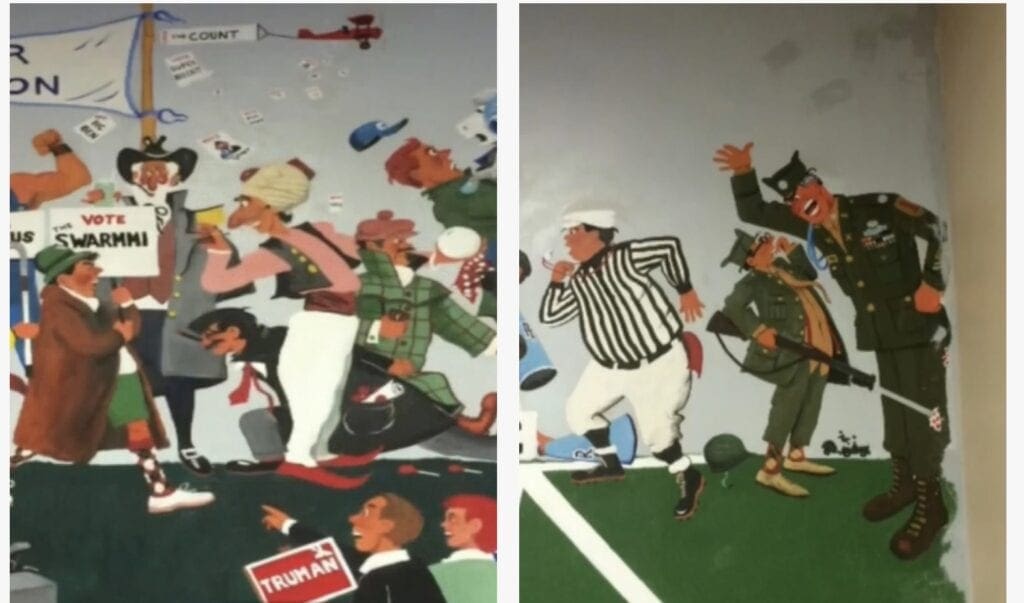

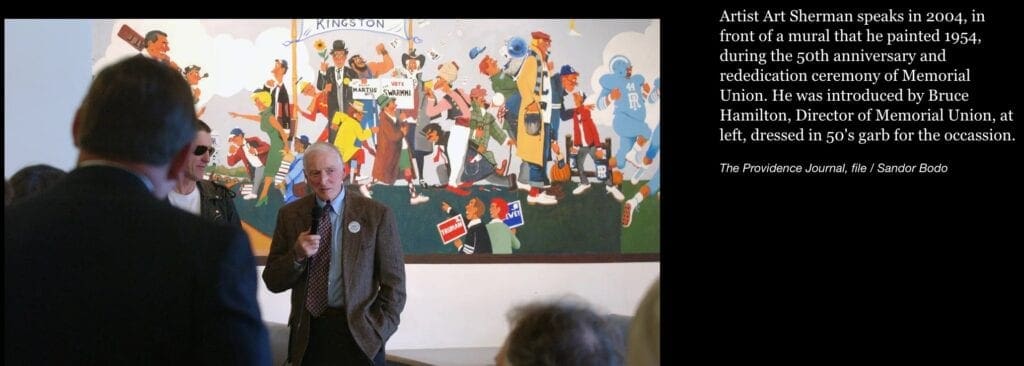
From 2020 ProJo interview with Corp. Sherman’s daughter, Pam: “With heightened awareness about the murals and the support of the veteran community, Pam Sherman and the rest of her family are hopeful that one — if not both — of the murals will be preserved to document the evolution of the University of Rhode Island and the transformative role that the school played in the lives of veterans who were able to benefit from the GI Bill.”
